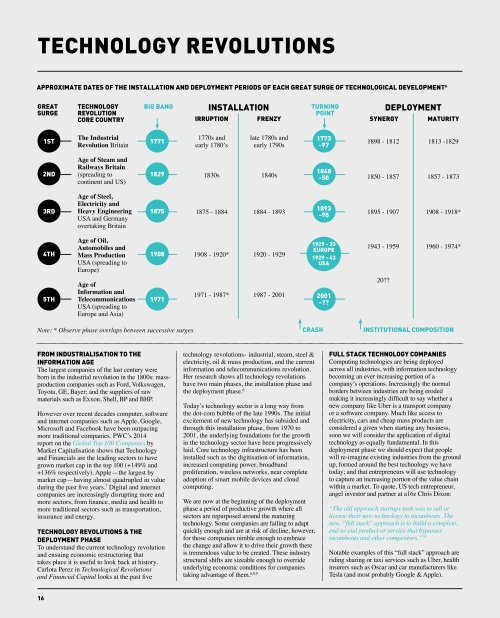STARTUP ECOSYSTEM PRELIMINARY REPORT
Western_Australia_Startup_Report_Dec_2015
Western_Australia_Startup_Report_Dec_2015
Create successful ePaper yourself
Turn your PDF publications into a flip-book with our unique Google optimized e-Paper software.
TECHNOLOGY REVOLUTIONS<br />
APPROXIMATE DATES OF THE INSTALLATION AND DEPLOYMENT PERIODS OF EACH GREAT SURGE OF TECHNOLOGICAL DEVELOPMENT 6<br />
GREAT<br />
SURGE<br />
TECHNOLOGY<br />
REVOLUTION<br />
CORE COUNTRY<br />
BIG BANG<br />
INSTALLATION<br />
IRRUPTION<br />
FRENZY<br />
TURNING<br />
POINT<br />
SYNERGY<br />
DEPLOYMENT<br />
MATURITY<br />
The Industrial<br />
1ST 1771<br />
Revolution Britain<br />
1770s and<br />
early 1780’s<br />
late 1780s and<br />
early 1790s<br />
1773<br />
-97<br />
1898 - 1812<br />
1813 -1829<br />
2ND<br />
Age of Steam and<br />
Railways Britain<br />
(spreading to<br />
continent and US)<br />
1829<br />
1830s<br />
1840s<br />
1848<br />
-50<br />
1850 - 1857<br />
1857 - 1873<br />
3RD<br />
Age of Steel,<br />
Electricity and<br />
Heavy Engineering<br />
USA and Germany<br />
overtaking Britain<br />
1875<br />
1875 - 1884<br />
1884 - 1893<br />
1893<br />
-95<br />
1895 - 1907<br />
1908 - 1918*<br />
4TH<br />
Age of Oil,<br />
Automobiles and<br />
Mass Production<br />
USA (spreading to<br />
Europe)<br />
1908<br />
1908 - 1920*<br />
1920 - 1929<br />
1929 - 33<br />
EUROPE<br />
1929 - 43<br />
USA<br />
1943 - 1959<br />
1960 - 1974*<br />
5TH<br />
Age of<br />
Information and<br />
Telecommunications<br />
USA (spreading to<br />
Europe and Asia)<br />
1971<br />
1971 - 1987*<br />
1987 - 2001<br />
2001<br />
-??<br />
20??<br />
Note: * Observe phase overlaps between successive surges<br />
CRASH<br />
INSTITUTIONAL COMPOSITION<br />
FROM INDUSTRIALISATION TO THE<br />
INFORMATION AGE<br />
The largest companies of the last century were<br />
born in the industrial revolution in the 1800s: massproduction<br />
companies such as Ford, Volkswagen,<br />
Toyota, GE, Bayer; and the suppliers of raw<br />
materials such as Exxon, Shell, BP and BHP.<br />
However over recent decades computer, software<br />
and internet companies such as Apple, Google,<br />
Microsoft and Facebook have been outpacing<br />
more traditional companies. PWC’s 2014<br />
report on the Global Top 100 Companies by<br />
Market Capitalisation shows that Technology<br />
and Financials are the leading sectors to have<br />
grown market cap in the top 100 (+149% and<br />
+136% respectively). Apple — the largest by<br />
market cap — having almost quadrupled in value<br />
during the past five years. 7 Digital and internet<br />
companies are increasingly disrupting more and<br />
more sectors, from finance, media and health to<br />
more traditional sectors such as transportation,<br />
insurance and energy.<br />
TECHNOLOGY REVOLUTIONS & THE<br />
DEPLOYMENT PHASE<br />
To understand the current technology revolution<br />
and ensuing economic restructuring that<br />
takes place it is useful to look back at history.<br />
Carlota Perez in Technological Revolutions<br />
and Financial Capital looks at the past five<br />
technology revolutions - industrial, steam, steel &<br />
electricity, oil & mass production, and the current<br />
information and telecommunications revolution.<br />
Her research shows all technology revolutions<br />
have two main phases, the installation phase and<br />
the deployment phase. 6<br />
Today’s technology sector is a long way from<br />
the dot-com bubble of the late 1990s. The initial<br />
excitement of new technology has subsided and<br />
through this installation phase, from 1970 to<br />
2001, the underlying foundations for the growth<br />
in the technology sector have been progressively<br />
laid. Core technology infrastructure has been<br />
installed such as the digitisation of information,<br />
increased computing power, broadband<br />
proliferation, wireless networks, near complete<br />
adoption of smart mobile devices and cloud<br />
computing.<br />
We are now at the beginning of the deployment<br />
phase a period of productive growth where all<br />
sectors are repurposed around the maturing<br />
technology. Some companies are failing to adapt<br />
quickly enough and are at risk of decline, however,<br />
for those companies nimble enough to embrace<br />
the change and allow it to drive their growth there<br />
is tremendous value to be created. These industry<br />
structural shifts are sizeable enough to override<br />
underlying economic conditions for companies<br />
taking advantage of them. 6,8,9<br />
FULL STACK TECHNOLOGY COMPANIES<br />
Computing technologies are being deployed<br />
across all industries, with information technology<br />
becoming an ever increasing portion of a<br />
company’s operations. Increasingly the normal<br />
borders between industries are being eroded<br />
making it increasingly difficult to say whether a<br />
new company like Uber is a transport company<br />
or a software company. Much like access to<br />
electricity, cars and cheap mass products are<br />
considered a given when starting any business,<br />
soon we will consider the application of digital<br />
technology as equally fundamental. In this<br />
deployment phase we should expect that people<br />
will re-imagine existing industries from the ground<br />
up, formed around the best technology we have<br />
today; and that entrepreneurs will use technology<br />
to capture an increasing portion of the value chain<br />
within a market. To quote, US tech entrepreneur,<br />
angel investor and partner at a16z Chris Dixon:<br />
“The old approach startups took was to sell or<br />
license their new technology to incumbents. The<br />
new, “full stack” approach is to build a complete,<br />
end-to-end product or service that bypasses<br />
incumbents and other competitors.” 10<br />
Notable examples of this “full stack” approach are<br />
riding sharing or taxi services such as Uber, health<br />
insurers such as Oscar and car manufacturers like<br />
Tesla (and most probably Google & Apple).<br />
16


